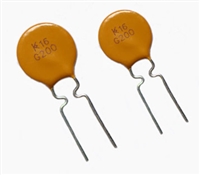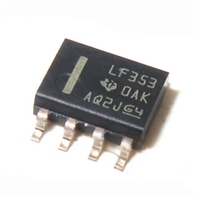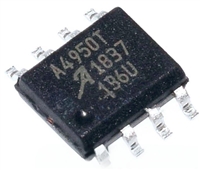AD630
TWO WAYS TO LOOK AT THE AD630
The two closed-loop gain magnitudes will be equal when RF/RA
= 1 + RF/RB, which will result from making RA equal to RFRB/
(RF + RB) the parallel equivalent resistance of RF and RB.
The functional block diagram of the AD630 (see page 1) shows
the pin connections of the internal functions. An alternative archi-
tectural diagram is shown in Figure 1. In this diagram, the
individual A and B channel preamps, the switch, and the inte-
grator output amplifier are combined in a single op amp. This
amplifier has two differential input channels, only one of which
is active at a time.
The 5 kΩ and the two 10 kΩ resistors on the AD630 chip can
be used to make a gain of 2 as shown below. By paralleling
the 10 kΩ resistors to make RF equal to 5 kΩ and omitting RB,
the circuit can be programmed for a gain of 1 (as shown in
Figure 9a). These and other configurations using the on-chip
resistors present the inverting inputs with a 2.5 kΩ source imped-
ance. The more complete AD630 diagrams show 2.5 kΩ resistors
available at the noninverting inputs which can be conveniently
used to minimize errors resulting from input bias currents.
+V
S
11
15
14
16
1
R
5k⍀
R
B
10k⍀
A
2.5k⍀
R
10k⍀
2
F
R
10k⍀
F
A
B
20
19
18
R
5k⍀
A
13
V
i
R
R
12
7
R
F
B
2.5k⍀
V
= –
V
O
i
10k⍀
17
A
B/A
9
SEL B
SEL A
10
Figure 3. Inverting Gain Configuration
8
–V
S
Figure 1. Architectural Block Diagram
HOW THE AD630 WORKS
V
i
R
F ) V
R
5k⍀
A
V
= (1+
O
i
R
B
The basic mode of operation of the AD630 may be easier to recog-
nize as two fixed gain stages which can be inserted into the signal
path under the control of a sensitive voltage comparator. When
the circuit is switched between inverting and noninverting gain, it
provides the basic modulation/demodulation function. The AD630
is unique in that it includes laser wafer trimmed thin-film feed-
back resistors on the monolithic chip. The configuration shown in
Figure 2 yields a gain of 2 and can be easily changed to 1 by
shifting RB from its ground connection to the output.
R
10k⍀
R
B
10k⍀
F
Figure 4. Noninverting Gain Configuration
CIRCUIT DESCRIPTION
The simplified schematic of the AD630 is shown in Figure 5.
It has been subdivided into three major sections, the comparator,
the two input stages, and the output integrator. The compara-
tor consists of a front end made up of Q52 and Q53, a flip-flop
load formed by Q3 and Q4, and two current steering switching
cells Q28, Q29 and Q30, Q31. This structure is designed so that
a differential input voltage greater than 1.5 mV in magnitude
applied to the comparator inputs will completely select one of
the switching cells. The sign of this input voltage determines
which of the two switching cells is selected.
The comparator selects one of the two input stages to complete
an operational feedback connection around the AD630. The
deselected input is off and has a negligible effect on the operation.
R
A
5k⍀
16
15
V
i
R
10k⍀
F
2
A
B
20
V
O
19
18
13
R
B
CH A+ CH B+
CH A–
20
CH B–
18
10k⍀
19
2
14
11
+V
S
9
Q35
Q33
Q36
Q34
i
i
10
73
55
Q44
SEL A
10
Figure 2. AD630 Symmetric Gain ( 2)
Q53
Q62
Q52
Q65
Q67
Q70
13
V
OUT
When Channel B is selected, the resistors RA and RF are
connected for inverting feedback as shown in the inverting
gain configuration diagram in Figure 3. The amplifier has suffi-
cient loop gain to minimize the loading effect of RB at the
virtual ground produced by the feedback connection. When the
sign of the comparator input is reversed, Input B will be dese-
lected and A will be selected. The new equivalent circuit will be
the noninverting gain configuration shown in Figure 4. In this
case, RA will appear across the op amp input terminals, but since
the amplifier drives this difference voltage to zero, the closed-loop
gain is unaffected.
9
Q74
SEL B
C121
Q30
12
COMP
Q31
C122
Q25
Q28
Q32
Q29
Q24
i
i
22
23
Q4
Q3
8
–V
S
5
3
4
6
DIFF
OFF ADJ
DIFF
OFF ADJ
CM
CM
OFF ADJ OFF ADJ
Figure 5. AD630 Simplified Schematic
–6–
REV. E






 NTC热敏电阻与PTC热敏电阻的应用原理及应用范围
NTC热敏电阻与PTC热敏电阻的应用原理及应用范围

 GTO与普通晶闸管相比为什么可以自关断?为什么普通晶闸管不能呢?从GTO原理、应用范围带你了解原因及推荐型号
GTO与普通晶闸管相比为什么可以自关断?为什么普通晶闸管不能呢?从GTO原理、应用范围带你了解原因及推荐型号

 LF353数据手册解读:特性、应用、封装、引脚说明、电气参数及替换型号推荐
LF353数据手册解读:特性、应用、封装、引脚说明、电气参数及替换型号推荐

 A4950资料手册解读:特性、应用、封装、引脚功能、电气参数及代换型号
A4950资料手册解读:特性、应用、封装、引脚功能、电气参数及代换型号
